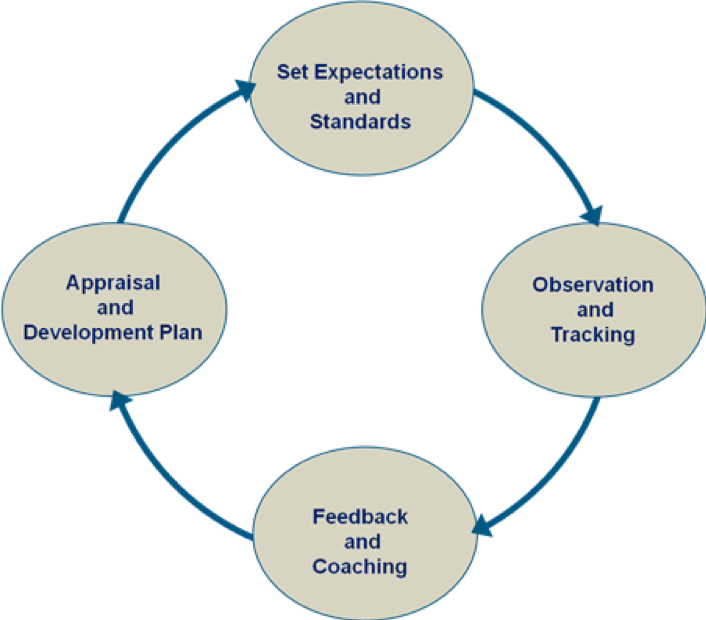Performance Evaluation Guide
EFFECTIVE PERFORMANCE MANAGEMENT requires: (1) setting clear expectations; (2) observing and tracking performance; and (3) providing ongoing coaching and feedback. Attention to these steps in the performance management process ensures that (4) performance appraisals, including discussions about development plans, are effective and beneficial to the employee, supervisor and overall organization. The performance appraisal is an opportunity to synthesize and capture the highlights of a full-cycle of performance in one document and to begin to plan for the next cycle of performance.

I: Establish Goals/Objectives for the Performance Period
Clear goals and objectives are the foundation for ongoing constructive performance management by facilitating reflection on past accomplishments and preparation for future success. The performance evaluation form captures whether the employee achieved the critical and agreed upon specific goals or objectives (duties, tasks, projects, etc.) that were identified for the performance period under review. Meeting standards of performance directly relates to whether or not goals or objectives were met.
II: Collect Information about Employee Performance
Over the course of the performance period, information regarding employee performance is captured on an ongoing basis. This is done through direct observation, employee input, tracking tools or reports (project plans, checklists, activity logs), reviewing work in progress, customer feedback, and other appropriate input. The information that has been gathered should be objective, specific, and linked to performance standards, goals and outcomes. This will ensure objective and specific data are provided to support the overall performance evaluation.
III: Reflect on Feedback and Coaching Conversations
As employee performance is observed and tracked, employees receive ongoing feedback on how results compare to expectations. Feedback regarding progress against goals, coaching to reinforce sound performance, and guidance to address challenges are all intended to help the employee meet the agreed upon expectations. Behavioral feedback that describes observable behaviors or actions is more likely to reduce defensiveness and be acted upon by the employee.
IV: Write the Performance Appraisal and Development Plan
Complete the Performance Appraisal Form
To craft an effective appraisal, the supervisor needs to review performance goals and objectives, collect performance data and observations, and notes from performance discussions. The performance appraisal is essentially a compilation of conversations held with the employee over the course of the review period and, as such, should hold no true surprises for the employee.
Performance Elements describe key characteristics of the employee’s job and are specific to the core responsibilities of a position. Each of the following performance elements is not necessarily applicable to every job.
|
Communication (Written, Oral, and Presentation) |
(Applicable to supervisors and managers)
|
The Summary of Performance section is used to write a narrative summarizing the employee’s overall performance for the evaluation period. Describe the employee’s major assignments and accomplishments, key strengths, any performance shortfalls, and identify the specific performance elements (listed above) that characterize the employee’s performance during the review period. This section should capture the employee’s contribution to the team, the department, and the organization.
Performance Ratings reflect how an employee performed against expectations.
- When determining individual performance ratings, it is important to keep in mind that fully meets expectations is the standard and is commendable. Most employees will fall into this category.
- The partially meets expectations rating is to identify those aspects of performance or key responsibility which require improvement and/or additional training and development.
- Does not meet expectations is assigned when performance continually fails to meet acceptable standards or reasonable progress toward critical goals was not made.
- The consistently exceeds expectations category is intended for exemplary performance that consistently exceeds expectations in all essential areas of responsibility, and the overall quality of work was excellent.
The exceptional performance rating is intended to be used sparingly, as this highest level of performance is rare. This rating indicates the individual made a significant contribution and achieved high results under unique circumstances with minimal supervisory guidance.
Justifying ratings that go beyond or are below meets expectations with supporting comments and evidence is particularly important.
Set Goals and Future Directions
The closing section(s) of the review form are used to identify performance goals/objectives for the next review period, success measures and how skills/knowledge/competencies will be developed.
Organizational goals and objectives should be written using the SMART (Specific, Measurable, Action-Oriented, Relevant, and Target Dated) methodology. This section is critical for ongoing performance management. It can be used to encourage high-performers or address performance improvement areas, particularly as indicated by “partially meets” or “does not meet” overall performance ratings.
See also, PPSM 23: Performance Management for the University of California’s Policy regarding Performance Management.
See also, Procedure 23 – Performance Appraisal for the UCLA’s Campus Human Resources (CHR) Procedure regarding Performance Management.
Minimizing Bias In Performance Evaluations
Since employers use performance evaluations, or appraisals, to support everything from promotions to compensation, bias can undermine an organization’s talent management system and often leads to disaffected employees. Please see “Minimizing Bias in Performance Appraisal”, created by Gartner.com (2019, April 4), to assist in recognizing how performance evaluations are subject to bias and learn what can be done to alleviate this issue.
Also, it is recommended to avoid making general statements in a performance evaluation that reference any protected categories. Please review the University of California’s Discrimination, Harassment, and Affirmative Action in the Workplace document for definitions of protected categories, included in this policy.
